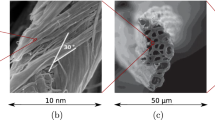Abstract
This study aims to analyze the influence of the fibrils oscillations and connections on the effective hygro-elastic behavior of the wood cell wall. For that, two different models of microstructure describing the cell wall are introduced: the model 1S, for which the fibrils are allowed to oscillate in one direction like a sine curve, and the model 2S, for which the fibrils oscillate in two directions as a helix. The effective hygro-elastic behavior of the cell wall associated with each of the two models is computed by numerical periodic homogenization. Then, we analyze the effects of the fibers oscillations on the effective behavior by making varying some parameters such as the shape ratio of the unit cell, the fibrils volume fraction, or the elastic contrast between the matrix and the fibrils. It is shown that the fibrils oscillations have a significant effect on some effective moduli of the cell wall, such as the effective shear moduli \({\widetilde{G}}_{12}\) (for both model 1S and 2S) and \({\widetilde{G}}_{13}\), \({\widetilde{G}}_{23}\) (for model 2S only).























Similar content being viewed by others
Change history
10 November 2022
A Correction to this paper has been published: https://doi.org/10.1007/s00707-022-03422-0
References
Terashima, N., Fukushima, K.: Heterogeneity in formation of lignin—XI: an autoradiographic study of the heterogeneous formation and structure of pine lignin. Wood Sci. Technol. 22, 259–270 (1988)
Harrington, J.J.: Hierarchical Modelling of Softwood Hygro-elastic Properties. University of Canterbury, Christchurch, New Zealand (2002)
Rafsanjani Abbasi, A.: Multiscale poroelastic model—bridging the gap from cellular to macroscopic scale. PhD thesis, ETH Zürich (2013)
Cave, I.: The anisotropic elasticity of the plant cell wall. Wood Sci. Technol. 2, 268–278 (1968)
Salmén, L., de Ruvo, A.: A model for the prediction of fiber elasticity. Wood Fiber Sci. 17(3), 336–350 (1985)
Persson, K.: Micromechanical Modelling of Wood and Fibre Properties (Structural Mechanics). Department of Mechanics and Materials Lund University, Sweden (2000)
Thuvander, F., Kifetew, G., Berglund, L.A.: Modeling of cell wall drying stresses in wood. Wood Sci. Technol. 36(3), 241–254 (2002)
Hofstetter, K., Gamstedt, E.K.: Hierarchical modelling of microstructural effects on mechanical properties of wood. A review COST Action E35 2004–2008: Wood Machining–Micromechanics and Fracture (2009)
Salmén, L.: Micromechanical understanding of the cell-wall structure. C. R. Biol. 327, 873–880 (2004)
Bardage, S., Donaldson, L., Tokoh, C., Daniel, G.: Ultrastructure of the cell wall of unbeaten Norwayspruce pulp fibre surfaces. Nord. Pulp Pap. Res. J. 19(4), 448–452 (2004)
Salmén, L., Stevanic, J.S., Holmqvist, C., Yu, S.: Moisture induced straining of the cellulosic microfibril. Cellulose 28(6), 3347–3357 (2021)
Salmén, L., Burgert, I.: Cell wall features with regard to mechanical performance. A review COST Action E35 2004–2008: Wood Machining–Micromechanics and Fracture (2009)
Boyd, J.D.: An anatomical explanation for visco-elastic and mechano-sorptive creep in wood, and effects of loading rate on strength. In: Baas P (ed) New perspectives in wood anatomy. Forestry sciences, vol 1. Springer, Dordrecht (1982). https://doi.org/10.1007/978-94-017-2418-0_8
Gril, J.: Une modélisation du comportement hygro-rhéologique du bois à partir de sa microstructure (Doctoral dissertation, Paris 6) (1988)
Reza, M., Ruokolainen, J., Vourinen, T.: Out-of-plane orientation of cellulose elementary fibrils on spruce tracheid wall based on imaging with high-resolution transmission electron microscopy. Planta 240(3), 565–573 (2014)
Goring, D.A.: Thermal softening of lignin, hemicelluolose and cellulose. Pulp Pap, pp. 517–527 (1963)
Norimoto, M., Gril, J.: Wood bending using microwave heating. J. Microw. Power Electromagn. Energy. 24(4), 203–212 (1989)
Inoue, M., Aoki, T., Egawa, G.: Development of a new teaching material utilizing recovery of compressive set of wood. Wood Res. Tech. Notes 28, 59–71 (1992)
Bornert, M., Bretheau, T., Gilormini, P.: Homogénéisation en mécanique des matériaux, Tome 1: Matériaux aléatoires élastiques et milieux périodiques (pp. 250). Hermes Science (2001)
Tang, R.C., Hsu, N.N.: Analysis of the relationship between microstructure and elastic properties of the cell wall. Wood Fiber Sci. 5(2), 139–151 (1973)
Ruel, K., Barnould, F., Eriksson, E.: Ultrastructural aspects of wood degradation by sporotrichum pulverulentum—observations on spruce wood impregnated with glucose. Holzforschung 38, 61–68 (1984)
Cristian Neagu, R., Kristofer Gamstedt, E., Bardage, S.L., Lindström, M.: Ultrastructural features affecting mechanical properties of wood fibres. Wood Mat. Sci. Eng. 1(3–4), 146–170 (2006)
Nishino, T., Takano, K., Nakamae, K.: Elastic modulus of the crystalline regions of cellulose polymorphs. J. Polym. Sci. Part B Polym. Phys. 33(11), 1647–1651 (1995)
Mark, R.: Cell Wall Mechanics of Tracheids. Yale University Press, New Haven, USA (1967)
Cave, I.D.: Modelling moisture-related mechanical properties of wood part I: properties of the wood constituents. Wood Sci. Technol. 12(1), 75–86 (1978)
Cousins, W.J.: Young’s modulus of hemicellulose as related to moisture content. Wood Sci. Technol. 12(3), 161–167 (1978)
Bodig, J., Jayne, B.: Mechanics of Wood and Wood Composites, Van Nostrand Reinhold. ed, Colección general Biblioteca (1982)
Author information
Authors and Affiliations
Corresponding author
Additional information
Publisher's Note
Springer Nature remains neutral with regard to jurisdictional claims in published maps and institutional affiliations.
Appendix
Appendix
1.1 Appendix A: components of the tensor of compliance
For an orthotropic elastic behavior, the expressions of the components of the compliance tensor \(\widetilde{{\underline{{\underline {S} }} }}\), as defined by Eq. (9), as functions of the ones of the tensor of elastic moduli \(\widetilde{{\underline{{\underline {C} }} }}\) are given in Table 4.
Rights and permissions
Springer Nature or its licensor (e.g. a society or other partner) holds exclusive rights to this article under a publishing agreement with the author(s) or other rightsholder(s); author self-archiving of the accepted manuscript version of this article is solely governed by the terms of such publishing agreement and applicable law.
About this article
Cite this article
Phan, NT., Auslender, F., Gril, J. et al. Influence of the cross-linking of the cellulosic fibrillar network on the effective hygro-mechanical behavior of the wood cell wall. Acta Mech 233, 4985–5007 (2022). https://doi.org/10.1007/s00707-022-03355-8
Received:
Revised:
Accepted:
Published:
Issue Date:
DOI: https://doi.org/10.1007/s00707-022-03355-8




